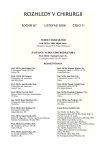Operation Treatment of the Humeral Shaft Fractures
Authors:
K. Šmejkal 1,2; T. Dědek 2; P. Lochman 1,2; J. Zahradníček 2; I. Žvák 1,2; J. Trlica 2
Authors‘ workplace:
Katedra válečné chirurgie, Fakulta vojenského zdravotnictví UO Hradec Králové, vedoucí katedry:
doc. MUDr. L. Klein, CSc.
1; Chirurgická klinika FN a LF UK Hradec Králové, přednosta kliniky: doc. MUDr. A. Ferko, CSc.
2
Published in:
Rozhl. Chir., 2008, roč. 87, č. 11, s. 580-584.
Category:
Monothematic special - Original
Overview
Introduction:
Nowadays the humeral shaft fractures represent about 4% of all fractures. Most of them can be treated conservatively. In this type of treatment the cooperation of the patient is necessary, treatment is long lasting and needs the extremity to be immobilized. That’s why still more fractures are indicated for the operation treatment, which enables an early rehabilitation and selfcare of the patient.
Aim:
The aim of our work was to assess the functional and clinical results in patients after the operation of the humeral shaft fractures treated by closed reposition and intramedullary fixation or by open reposition and plate osteosynthesis (ORIF).
Design:
Retrospective descriptive study – case serie
Material and methods:
In our department within the years 2001–2006 we operated on 101 patients with humeral shaft fractures. 65 patients came to be checked, the follow up rate – 65%. Fractures were classified according AO: A – 50%, B – 29%, C – 21%. The ORIF was used in 18 patients, closed reduction and locked intramedullary nail in 21 patients, and closed reduction and K-wires bundle (Hackethal) in 26 patients.
Results:
The resulting conditions we evaluated by Constant-Murley and Liverpool elbow scoring system. The mean value reached 86/8.9. In 82% of patients we have reached good to excellent results. Complications were noted in 34
Conclusion:
In spite of limited number of patients in our study the results of ours generally are not in contradiction to the current literature data. The best results were achieved by ORIF. On the contrary, the worst outcomes with greatest number of complications were in Hackethal group.
Key words:
humeral shaft fractures – closed reposition and intramedullary osteosynthesis – open reposition and plate osteosynthesis
Sources
1. Sarmiento, A., Zagorski, J. B., Zych, G. A., et al. Functional Bracing for the Treatment of Fractures of the Humeral Diaphysis. J. Bone Joint Surg., vol. 82, 2000, p. 478–486.
2. Wallny, T., Westermann, K., Sagabiel, C., et al. Functional Treatment of Humeral Shaft Fractures: Indication and Results. J. Orthop. Trauma, vol. 11, 1997, p. 283–287.
3. Bhandari, M., Deveraux, P. J., McKee, M. D., et al. Compression plating versus intramedullary nailing of humeral shaft fractures – a meta analysis. Act. Orthop., vol. 77, 2006, p. 279–284.
4. Chapman, J. R., Henley, M. B., Agel, J. B., et al. Randomized Prospective Study of Humeral Shaft Fracture Fixation: Intramedullary Nails Versus Plates. J. Orthop. Trauma, vol. 14, 2000, p. 162–166.
5. McCormac, R. G., Brien, D., Buckley, R. E. Fixation of the shaft of the humerus by dynamic compression plate or intramedullary nail. J. Bone Joint Surg., vol. 82, 2000, p. 336–339.
6. Chao, T. Ch., Chou, W. Y., Chung, J. Ch., et al. Humeral shaft fractures treated by dynamic compression plates, Ender nails and interlocking nails. Int. Orthop., vol. 29, 2005, p. 88–91.
7. Changulani, M., Jain, U. K., Keswani, T. Comparison of the use of the humerus intramedullary nail and dynamic compression plate for the management of diaphyseal fractures of the humerus. A randomized controlled study. Int. Orthop., vol. 31, 2007, p. 391–395.
8. Linn, J. Treatment of Humeral Shaft Fractures with Humeral Locked Nail and Comparison with Plate Fixation. J. Trauma, vol. 44, 1998, p. 859–864.
9. Martinez, A. A., Cuenca, J., Herrera, A. Treatment of humeral shaft nonunions: nailing versus plating. Arch. Orthop. Trauma Surg., vol. 124, 2004, p. 92–95.
10. Lin, J., Inoue, N., Valdevit, A., et al. Biomechanical Comparison of Antegrade and Retrograde Nailing of Humeral Shaft Fracture. Clin. Orthop., vol. 351, 1995, p. 203–213.
11. Lin, J., Shen, P. W., Hou, S. M. Complication of Locked Nailing in Humeral Shaft Fractures. J. Trauma, vol. 54, 2003, p. 943–949.
12. Rommens, P. M., Verbruggen, J., Broos, P. L. Retrograde Locked Nailing of Humeral Shaft Fractures. J. Bone Joint Surg., vol. 77, 1995, p. 84–89.
13. Scheerlinck, T., Handelberg, F. Functional Outcome after Intramedullary Nailing of Humeral Shaft Fractures: Comparison between Retrograde Marchetti-Vincenzi and Unreamed AO Antegrade Nailing. J. Trauma, vol. 52, 2002, p. 60–71.
14. Peter, R. E., Hoffmeyer, P., Henley, M. B. Treatment of humeral diaphyseal fractures with Hackethal stacked nailing: a report of 33 cases. J. Orthop. Trauma, vol. 6, 1992, p. 14–17.
15. Henley, M. B., Chapman, J. R., Claudi, B. F. Closed retragrade Hackethal nail stabilization of humeral shaft fractures. J. Orthop. Trauma, vol. 6, 1992, p. 18–24.
16. Lau, T. W., Leung, F., Chan, C. F., et al. Minimally invasive plate osteosynthesis in the treatment of proximal humeral fracture. Int. Orthop., vol. 31, 2007, p. 657–664.
17. Zhiquan, A., Bingfang, Z., Yeming, W., et al. Minimally Invasive Plating (MIPO) of Middle and Distal Third Humeral Shaft Fractures. J. Orthop. Trauma, vol. 21, 2007, p. 628–633.
18. Jiang, R., Luo, C. F., Zeng, B. F., et al. Minimally invasive plating for complex humeral shaft fractures. Arch. Orthop. Trauma Surg., vol. 127, 2007, p. 531–535.
Labels
Surgery Orthopaedics Trauma surgeryArticle was published in
Perspectives in Surgery

2008 Issue 11
Most read in this issue
- The Use of Biodegradable Materials in the Management of Bone Cysts in Children
- Biliary Ileus – Potential Complication of Cholecystolithiasis
- Operation Treatment of the Humeral Shaft Fractures
- Minimally Invasive Surgery in the Czech Republic
